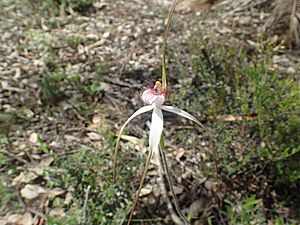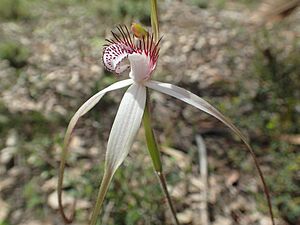Tangled white spider orchid facts for kids
Quick facts for kids Tangled white spider orchid |
|
|---|---|
 |
|
| Caladenia longicauda subsp. redacta growing in the Mundaring State Forest | |
| Scientific classification |
|
| Kingdom: | Plantae |
| Clade: | Tracheophytes |
| Clade: | Angiosperms |
| Clade: | Monocots |
| Order: | Asparagales |
| Family: | Orchidaceae |
| Subfamily: | Orchidoideae |
| Tribe: | Diurideae |
| Genus: | Caladenia |
| Species: | |
| Subspecies: |
C. l. subsp. redacta
|
| Trinomial name | |
| Caladenia longicauda subsp. redacta Hopper & A.P.Br.
|
|
| Synonyms | |
|
Arachnorchis longicauda subsp.redacta (Hopper & A.P.Br.) D.L.Jones & M.A.Clem. |
|
The tangled white spider orchid (scientific name: Caladenia longicauda subsp. redacta) is a special type of orchid. It grows only in the south-west part of Western Australia. This means it's endemic there, found nowhere else in the world!
This orchid has one fuzzy leaf. It also grows up to three big, mostly white flowers. These flowers have long, hanging parts called sepals and petals. It looks a lot like another orchid, Caladenia longicauda subsp. eminens. However, the tangled white spider orchid has smaller flowers. Its labellum (a special lip-like petal) also has shorter teeth on its sides.
Contents
What the Tangled White Spider Orchid Looks Like
The tangled white spider orchid is a ground-dwelling plant. It is a perennial herb, meaning it lives for more than two years. It also loses its leaves each year (it's deciduous).
Under the ground, it has a special storage part called a tuber. Each plant grows a single hairy leaf. This leaf is usually about 10 to 25 centimeters (4 to 10 inches) long. It is also about 0.8 to 1.2 centimeters (0.3 to 0.5 inches) wide.
The orchid can grow up to three flowers on a tall stem. This stem is usually 20 to 40 centimeters (8 to 16 inches) tall. The flowers are mostly white and quite large. They are about 8 to 12 centimeters (3 to 5 inches) long. They are also 6 to 8 centimeters (2 to 3 inches) wide.
- The dorsal sepal (the top part of the flower) stands straight up. It is about 6 to 8 centimeters (2 to 3 inches) long. It is also 0.2 to 0.4 centimeters (0.1 to 0.2 inches) wide.
- The lateral sepals (the side parts) are 6 to 9 centimeters (2 to 4 inches) long. They are 0.4 to 0.8 centimeters (0.2 to 0.3 inches) wide.
- The petals are 5 to 8 centimeters (2 to 3 inches) long. They are 0.25 to 0.4 centimeters (0.1 to 0.2 inches) wide.
All these parts spread out at their base. Then, they suddenly become narrow and hang down. The labellum (the orchid's lip) is white. It is about 1.5 to 1.8 centimeters (0.6 to 0.7 inches) long. It is also 0.7 to 1.0 centimeter (0.3 to 0.4 inches) wide. It has thin teeth along its edges, up to 0.5 centimeters (0.2 inches) long. In the middle of the labellum, there are two or four rows of pale red bumps called calli.
This beautiful orchid usually blooms from September to mid-October.
How it Got its Name
The scientific name Caladenia longicauda was first officially described in 1840. This description was made by a person named John Lindley. It was published in a book called A Sketch of the Vegetation of the Swan River Colony.
Later, in 2001, two scientists, Stephen Hopper and Andrew Brown, described eleven different types (subspecies) of this orchid. One of these was subspecies redacta. Their descriptions were published in a scientific journal called Nuytsia.
The name redacta comes from a Latin word. It means "edited" or "reduced." This name was chosen because the tangled white spider orchid's flowers are quite small. They are smaller compared to the flowers of other types of Caladenia longicauda.
Where it Lives
The tangled white spider orchid mostly grows in the area between Collie, Mount Barker, and York. These places are in the Avon Wheatbelt and Jarrah Forest areas of Western Australia.
It likes to grow in flat areas. These areas often get flooded with water during the winter months.
How it is Protected
The Western Australian Government's Department of Parks and Wildlife has looked at the tangled white spider orchid. They have classified it as "not threatened." This means that, for now, there are enough of these orchids in the wild. They are not in danger of disappearing.


